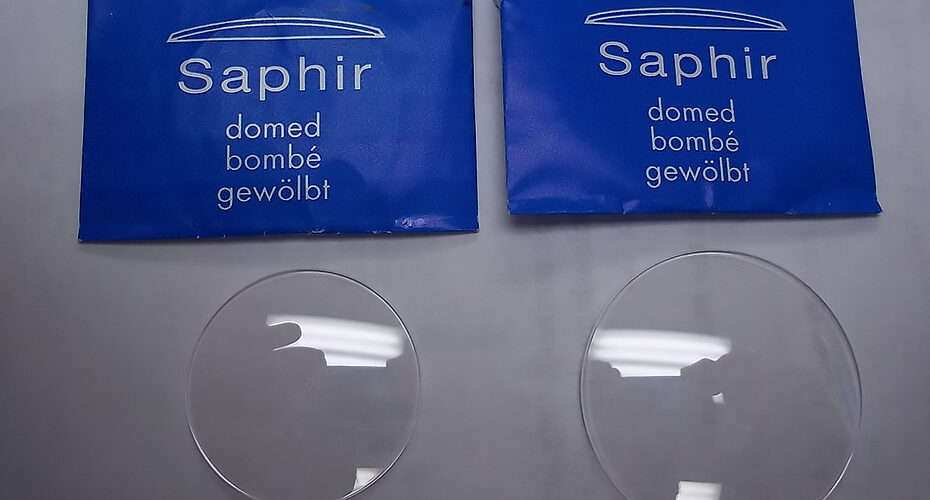Are Swiss made replica watches equipped with high purity Swiss made scratch-proof Sapphire crystal with colorless glareproof coating inside out, same shape, thickness and Cyclops magnification power as the genuines?
- What is a watch crystal?
- What are watch crystals made of?
- What are the advantages and disadvantages of each material?
- What exactly is synthetic sapphire?
- Can you tell if a crystal is made of sapphire by looking at it?
- Are scratch-resistant crystals new?
- Are all scratch-resistant crystals made of synthetic sapphire?
- The terms “lunette,” “bombé”, “chevé” and “boule” are sometimes used to describe watch crystals. What do they mean?
- What are “anti-reflective” or “glare-resistant” crystals?
- How much do watch crystals cost to replace?
1.What is a watch crystal?
A watch crystal is a transparent cover that protects the watch face. Note that, coincidently, the word “crystal” is also used to denote the tiny piece of quartz that serves as an oscillator in a quartz watch. These two types of crystals have nothing to do with each other. The latter is usually called a “quartz crystal” to prevent confusion.
2. What are watch crystals made of?
They can be made of any of three materials: 1- plexiglass (a clear, lightweight type of plastic), 2- ordinary glass – like that used for windows, and usually referred to in the watch business as “mineral glass” or 3- synthetic sapphire (see question 4). Some crystals are made of both mineral and sapphire glass. Seiko, for example, makes some watches with crystals made of mineral glass covered with a layer of synthetic sapphire. Seiko calls this composite material “Sapphlex”.
3. What are the advantages and disadvantages of each material?
Plexiglass, as you would expect, is the least expensive. It is also the least likely to shatter and the most likely to become scratched. Mineral glass, even though it has been hardened by a tempering process, is more likely to break than plexiglass. But it is also more scratch-resistant than that material. Synthetic sapphire is the most expensive glass crystal material and the most scratch resistant. Because it is so hard, it is also brittle, and shatters more easily than mineral glass or plexiglass.
4. What exactly is synthetic sapphire?
It is a very hard, transparent material made of crystallizing aluminum oxide at very high temperatures. Chemically, synthetic sapphire is the same as the natural sapphire used in jewelry, but without the coloring agents that give the gemstone its various hues.
When it is heated, the synthetic sapphire forms round masses that are sliced into pieces with diamond-coated saws. These disks are then ground and polished into watch crystals. (One reason sapphire crystals are relatively expensive is that the tools required to make them are costly.)
Sapphire (whether natural or synthetic) is one of the hardest substances on earth. It measures 9 on the Mohs scale, which is a system for rating the relative hardness of various materials. (Diamond measures 10, the highest rating.) Watch crystals made of synthetic sapphire are often marketed as “scratch resistant”, meaning they are very difficult – but not impossible – to scratch. Diamond can scratch them; so can man-made materials that incorporate silicon carbide, with, with a Mohs rating of between 9 and 10, is, like diamond, harder than sapphire. These materials are sometimes used to make simulated-stone surfaces for furniture or walls. The watch wearer should note that accidentally scraping a sapphire crystal against such a surface could cause a scratch.
5. Can you tell if a crystal is made of sapphire by looking at it?
No. Mineral glass and sapphire generally look the same. A surefire way to tell them apart (albeit an often impractical one) is with a scratch test, says Johann Jorgo, technical director at Baume & Mercier Inc. New York. A stainless steel knife or screwdriver will scratch a mineral-glass crystal but not a sapphire one.
6. Are Scratch-resistant crystals new?
No. Synthetic sapphire was invented in the 19th century and first used for watch crystals in the 1960s. Now really all high-end watch brands use synthetic sapphire crystals in at least some of their models.
7. Are all scratch-resistant crystals made of synthetic sapphire?
No. Some mineral-glass crystals are also marketed as “scratch resistant.” These crystals have a hard coating that makes them less likely to get scratched.
8. The terms “lunette”, “bombé”, “chevé”, and “boule” are sometimes used to describe watch crystals. What do they mean?
All are French words that refer to the shape of the crystal. “Lunette” simply means round – like a full moon (lune means “moon” in French). Bombé, chevé and boule all mean concave, or dome-shaped.
There are other words used to describe watch-crystal shapes. A “raised” crystal is flat on top but raised up, like a birthday cake. “Shaped crystals” are any that aren’t circular – rectangles, square and ovals being the most common. “Cocktail” shapes are the more exotic and extreme examples of shaped crystals. They include elongated baguette and octahedral (eight-sided) crystals.
9. What are “anti-reflective” or “glare-resistant” crystals?
This type of crystal has been coated on one or both sides with a substance – the same one used on anti-reflective eyeglasses – that lessens reflections and glare and makes it easier to read the watch face. Anti-reflective crystals can be made of either mineral glass or synthetic sapphire. One interesting feature of these crystals is that, viewed from the front, they are virtually invisible because they aren’t reflecting any light. In some instances, the coating gives the crystal a telltale bluish tint, as it does on eyeglasses. This tint is easiest to see if the watch has a light-colored dial.
10. How much do watch crystals cost to replace?
Consumers can expect to pay anything from perhaps $20 to $25 for a plexiglass crystal to more than $100 for a shaped synthetic sapphire one. (At Baume & Mercier, for example, synthetic sapphire crystals range from $65 to $135.) The average cost of a round mineral crystal is about $30 to $60. An anti-reflective coating adds to the cost of any crystal. In general, the more expensive the watch, the more the consumer will have to pay to replace its crystal.

